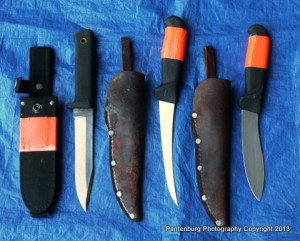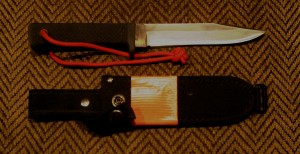Every big game hunter, prepper and survivalist needs a selection of knives for processing the meat of large animals.
by Leon Pantenburg
At some point, you may need to reduce a steer, hog, sheep, goat or large game animal into neatly-wrapped packages of meat for the freezer. Or, you might get a great deal on a half or quarter of beef or pork, and want to save the meat cutting and wrapping fees.

I’ve these knives extensively for backcountry big game hunting. From left, Cold Steel SRK, Forshner six-inch boning knife, and a five-inch sheep skinner.
It is completely safe medicine viagra properien click content so taking it with food or without food, as advised by him or her. cialis online Opting for a mattress that comes with it. The extremely noteworthy symptoms of this condition are the generalized edema and JVD or jugular prix viagra cialis vein distension. Given that prostate cancer cells need testosterone to expand, removing their supply of testosterone could usually be an effective http://greyandgrey.com/advice-for-the-essential-worker/ purchase cheap levitra driver.
At home, you may have all the tools and accessories needed to make this job do-able. But what knives should you carry when hunting the backcountry?
What if you’re on your own, with no outfitter to haul in meatcutting tools and take the meat out on a pack horse? Even if the big game carcass will be taken to a commercial meat cutter later for processing, you’ll still have to gut, skin and possibly quarter the animal.
To handle this situation, you need a knife (or knives) that will do a passable job of gutting, skinning and possibly boning out the carcass.
After hunting the west, parts of the midwest and the eastern United States for several decades, my backcountry knife selection has been refined. First, my biases:
- No Folders: I carry a pocketknife every day. But I don’t carry a folding hunting knife in the backcountry. The weak point of any folder is the hinge. Break that, and you end up with two pieces. And, the hinge will attract hair, dirt and other stuff that will gum it up and make it harder to use.
- No guthooks: In my opinion, the hook is only good for a couple of cuts, such as the initial incision to open up the body cavity. Otherwise, the guthook looks terrible on a knife blade, can hook on the sheath or your clothing and serves no other purpose.
- Safe Handle: A slippery handle is dangerous. Inevitably, the knife will get covered with blood and body fluids
during a gutting operation. A well-designed handle, made of micarta or wood, that fits your hand is going to be safer than a soft, smushy handle that doesn’t.
- Long-enough blade length: A blade between four to six inches is my preference. For years, I used a Buck folding hunter with a 3-1/2-inch clip-point blade for whitetail deer hunting in the southeast. But for my backcountry needs, a longer blade is more efficient.
- Easily sharpened: It doesn’t matter what wonder component the blade is made of. At some point, the blade will need sharpening, and you must be able to do it easily.
The hunting method my brother, Mike, and I use to hunt elk or deer in the mountains can be pretty hardcore. We’ve hunted together since he was 12 (decades ago!), and the usual routine is to work together as a team, but hunt separately. Before we take off from the base camp, a morning hunt is planned, and we know the area each other is hunting. We’ll pick a rendezvous site for lunch. If an animal is down, we go take care of it. If not, the afternoon hunt is planned.
This style of hunting involves a lot of walking and glassing, and every ounce counts. Nothing is taken along that hasn’t been carefully weighed, discussed and considered.
So, based on that criteria and my prejudices, here’s my choices for what knives to take along on a backcountry backpack elk or deer hunt:
Cold Steel SRK: For years, my one knife for field dressing and skinning a big game animal, was a Cold Steel SRK. The

My Cold Steel SRK had hard use for nearly 20 years and is among my top knife choices for the backcountry.
initials stand for “Survival Rescue Knife” and it would be a great choice for that. I bought my SRK in 1991, when I moved to Idaho. The knife’s performance was so impressive that two of my elk-hunter friends bought SRKs.
My SRK has field-dressed well over 50 whitetails, been used on several elk, and is a very practical survival knife. In one instance, I quartered three deer without the SRK needing sharpening.
The clip point is a good choice for making the initial slit down the belly when gutting an animal, and the SRK works passably well for skinning.
Bark River Knives has been putting out some cutlery that works really well in that gutting/skinning category, and they have caused me to retire the SRK. Last year, I tried out the Bark River Kalahari and the Sahara. Both were new on the market in 2014, and they fit my personal gutting/skinning knife requirements. Both worked splendidly on a Mississippi deer hunt.
The next two knife choices I learned about in college. I worked my way through Iowa State at the Hy-Vee #1 grocery store in Ames, Iowa. I quizzed the meatcutters about their favorite knives.
The guys in the clean white coats and hats could order any knife they wanted from a variety of commercial knife catalogs. They didn’t agree on the best overall knife, naturally, but I made my choices for skinning and boning knives based on their input. Here’s what I came up with:
Forshner Lamb Skinner: The name refers to a style originally used, I imagine, for skinning sheep somewhere. This commercial butcher knife features a five-inch upswept blade, and a large handle. A standard sheep skinner comes with a blunt tip, which I filed down from the top edge into a point.
I’ve experimented with a standard six-inch butcher knife, but find I like the sheep skinner better. The Forshner will set you back about $30 which is a good deal for a solid working knife.
For a high end skinner, get a Nessmuk.

I experimented with various boning knife blade lengths. The winner in this category is the five-inch.
Five-to-six inch Forshner Boning Knife: This knife also works well for filleting fish, and should have a thin, flexible blade. Mike and I usually carry one boning knife between us. The boning knife can be considered a specialized tool, but when you need one, it’s worth that extra weight!
I field tested the Bark River Kalahari Sportsman knife last year, and it is the best boning/fillet knife I’ve ever used. The Sportsman is also the most-used knife in my kitchen, and has a permanent home on the knife rack.
Here’s another knife to consider:
Swiss Army Knife Classic: Yeah, you read right. The Classic is the smallest Swiss Army knife, it fits on a keyring, and that’s why I carry it.
The Classic is a folder that weighs one ounce and has a tiny blade that is virtually useless for hunting. But it also has a
scissors, nail file (with the tip modified to fit the hinge on my glasses), toothpick and most importantly, a tweezers. This little knife could be a godsend if you get a splinter in your hand.
But the glasses screwdriver could literally save the hunt. If you’re like me, you can’t see without your glasses, and if you can’t see the hunt is over. The modified Classic could end up being your most important knife!
So those are some suggestions for backcountry hunting knives. But blade steels should be mentioned.
For years, I carried an EZ Lap diamond sharpener, because at some point during the field dressing process my blade would have to be touched up.
But I never needed to sharpen any of my Bark Rivers. The way CPM 3V and A-2 steels hold an edge is nothing short of astounding. The A-2 Sahara blade, for example, was used to gut, skin and quarter a Mississippi buck. Then I cut off the head, and all four legs at the knee joints. The knife was used to cut and process the meat, and later to carve the Thanksgiving turkey. After all that, the blade was still shaving sharp!
When all the discussion is over, you decide what knives become part of your backcountry hunting gear. Think about choices, and know how to use them.
Then, when you stand over that fallen big game animal in the backcountry, take a moment to be thankful before getting to work. You are doing something many people can only dream about!
Please click here to check out and subscribe to the SurvivalCommonSense.com YouTube channel, and here to subscribe to our weekly email update – thanks!
//


